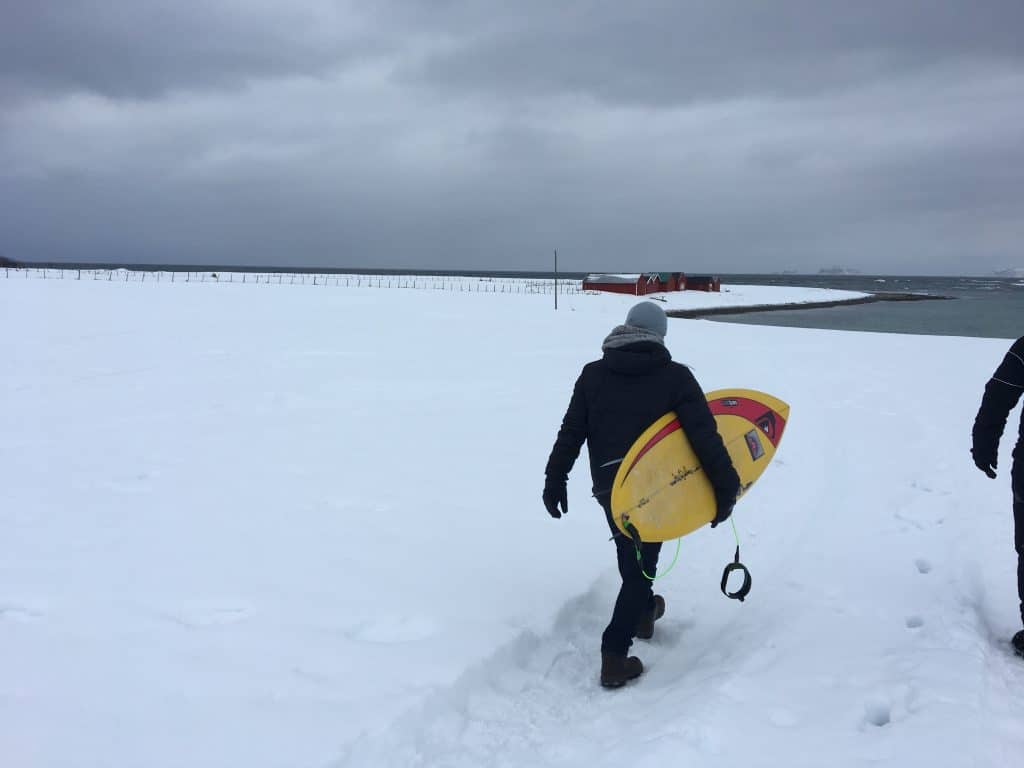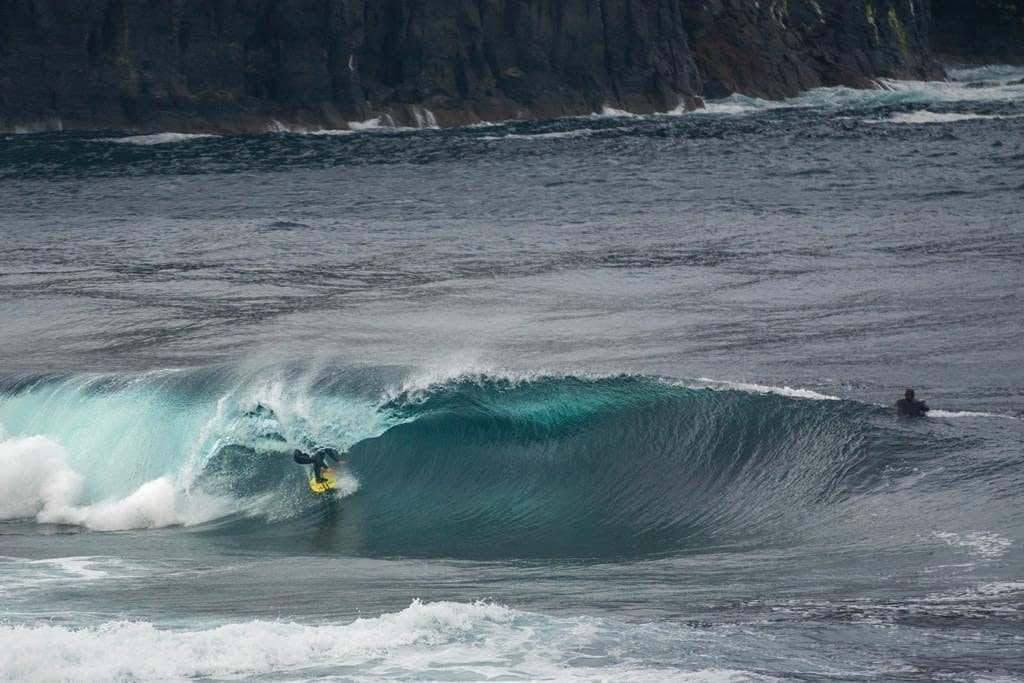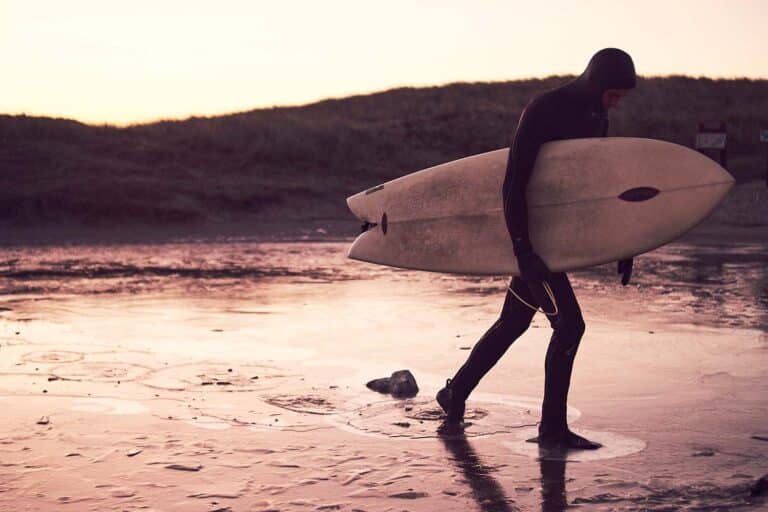Are Cold Water Surf Trips Vogue?
Historically when you close your eyes and dream of the perfect surf trip, your mind quickly drifts to an uncrowded, tropical island with warm weather and pumping waves. This is still the case for many people when thinking of their next surf trip, but these once uncrowded tropical setups are becoming harder to find across the globe. In addition, global travel has recently been restricted to many of these places, forcing many people to reconsider where their next perfect surf trip should be. Crowds, COVID and a bunch of other factors have seen an increased push towards cold and isolated areas for surf trips, so much so that they may be the new ideal surf trip.
As mentioned, there are many factors that are contributing towards the push to cold water surf trips. Every surfer prefers to surf with a minimal crowd, and this may be the biggest factor why people are moving away from the standard sunny or tropical surf trip. Although surfing in a thick wetsuit and gloves and boots is less attractive than a pair of trunks, I’m sure many surfer’s prefer this than dealing with crowded line-ups, which are less common in many cold water surf destinations. A sense of adventure is always at the heart of a surf trip, forged in the history and culture of surfing, and this is also a big reason why people are chasing cold, isolated surfing destinations. It seems that the sense of adventure may be expiring at our standard tropical surf destinations, which are now dotted with 5 star resorts, surf shops and schools. Many people believe that the heart of surf adventure should introduce you to new experiences, uncertainty and stimulation, which can be guaranteed on many cold water surf trips.

Searching for waves with Tom Carroll on a SurfEars trip in Norway a few years back.
Of course for a cold water surf trip to be viable, you need good waves. Good waves are usually the main focus of a surf trip, but are the waves in cold water destinations really up to the standard of tropical destinations like Indonesia and Central America? The answer to this is a resounding yes. The northern reaches of this planet in places like Scotland, Ireland, Iceland and Canada all have world class waves, and it only takes you a second on Instagram looking at some of the local boys from these areas charging to have this point validated. South Australia, Tasmania and the southern parts of Chile and Argentina also have a bunch of world class waves, whether you’re searching for chilled point breaks or mutant slabs and heavier waves! Yes there are definitely world class waves in cold water destinations, and there are many areas still to be explored!

Irish Charger @ollioflahrty charging a local slab. Photo: @thomashorig
Unlike your tropical surf destination, where you chuck in a couple of pairs of trunks, sunscreen and some flip flops, a cold water surf destination requires a bit more packing and planning. Warm clothes, a thicker wetsuit, gloves and boots are the standard. Luckily these days the quality of wetsuits are so good that a 5/4mm will cover you in even the coldest conditions with thick 5-7mm gloves and boots. Due to demand, prices have actually dropped in recent years, so you will not be paying an arm and leg for this equipment these days. Cold water and wind also have a big impact on your ears, so to avoid ear infections and a resurgence of your Surfer’s Ear, some SurfEars are definitely recommended as a surf essential for your cold water surf trip! In the words of one of Ireland’s finest chargers, Ollie O’Flaherty who is a regular at the insane slabs and big wave spots of Ireland “SurfEars allow you to keep your hearing while providing protection from the windy and cold elements in Ireland. It’s not easy to find this in a product and SurfEars have managed to nail that”.
These sentiments are backed up by Scottish photographer Sam Howard who is currently working on the ‘In Scotland We Surf’ project, “The cold water rushing into my ears was starting to become really painful. It was especially bad when swimming through big winter swells. It started to lean to ear infections and random aching outside the water. When I use my ear plugs I notice a big difference. It definitely reduces the impact that cold Scottish conditions have on your ears”.
Embracing the cold can be tough at times, but in return you will be rewarded with many of the great qualities that make up the essence of a true surf adventure. Some tips to help mitigate some of the harsher elements of a cold surf trip are as follows:
Equipment: As mentioned earlier most wetsuit brands 4/5mm hooded suits will be suitable for temperatures below 10 degrees. Some of our favourites at a fair price point are Needessentials and Surfce wetsuits. However it is important to ensure that you have quality gloves and boots. Warm hands and feet will go a long way to keeping you warmer and more comfortable in your surf in cold water. We recommend you to do some quality research to find top quality gloves and boots from 5-7mm. SurfEars are also highly recommended as previously explained. Even if you have a hood, water can still sneak in and then become even more trapped in your ears under the hood.
Pre-Surf: Staying warm before hitting the water is very important when heading out for a cold water session. We recommend putting your gear on inside (even before driving/walking to the waves) or in an area protected from the elements. If your body is warm and the blood is pumping when you hit the water, you will find it a lot more manageable and this will increase the length of your session. Some quick stretching, push-ups, squats and running down to the line-up can get the blood flowing and warm your body up in your suit before hitting the water.
During: As a carry on from your pre-surf ritual, it is important to keep the blood circulating once you hit the water, so try not to sit still too much whilst waiting for the waves. Keep moving and paddling (even if it’s in circles haha), to keep the blood pumping. Also duck diving in cold water can be an instant brain freeze and body cooler. Try to avoid duck diving as much as possible and when unavoidable try to keep your head tucked into your body/board and to one side to minimise exposure to cold water and stop it from coming into your hood and suit.
Post-Surf: A no-brainer is to have a dry towel and get changed in an area away from the elements after you surf. Something like Dryrobe is a perfect solution to minimising exposure to the cold after your session. You can even just jump in a Dryrobe and drive and walk home, where you can get changed inside in the warmth. Once out of your gear, it is important to hang it in a warm and dry area, so it can dry as quickly as possible for your next session. You will be thanking yourself over and over, if you go to the effort to dry out your suit before your next session!
Cover Image: @s.howard_photo somewhere in Scotland
Checkout some beautiful cold water conditions on the amazing series by Torren Martyn and Ishka Folkwell here:
